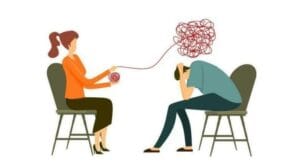Depression is often described as a shadow, a weight, or a fog—but these metaphors only begin to capture its complexity. It is, in fact, a silent storm—raging within, unseen by the outside world. While millions are affected by depression globally, each person’s experience is uniquely personal and profoundly different.
This blog post is not just an exploration of depression, but a compassionate guide to understanding its hidden depths. It’s also a call to action for anyone searching for a path out of the darkness.
Table of Contents
What Depression Really Feels Like
Depression is more than just “feeling sad.” It’s the mother who feels disconnected from her child despite her best efforts. It’s the teenager who endlessly scrolls through their phone, hoping to escape an all-consuming emptiness. It’s the professional who laughs in meetings but breaks down alone in the car afterward.
Depression is a thief. It robs you of your energy, joy, and connection to the world. It whispers that you’re not enough—that no matter how hard you try, you’ll never be free of its grip.
But here’s the truth: Depression lies. And understanding its nature is the first step toward reclaiming your life.
The Faces of Depression You Might Not Recognize
Depression doesn’t always announce itself with obvious signs. Often, it hides behind masks that we may not recognize:
- The Overachiever: On the surface, they seem to have it all—success, accolades, and charm. But beneath the façade, they feel exhausted and like they’re running on empty, unable to stop.
- The Caregiver: They devote themselves to others, but neglect their own needs, leaving them feeling hollow despite their kindness.
- The Quiet One: They rarely speak of their struggles, but their silence carries a world of pain.
- The Angry Soul: Depression can manifest as frustration or irritability—lashing out because it feels too vulnerable to seek help.
These hidden faces remind us that depression doesn’t look the same for everyone. Recognizing it in others—and ourselves—requires awareness and empathy.

The Science Behind the Struggle
Depression isn’t just “in your head.” It’s a full-body experience, rooted in chemical imbalances in the brain, hormonal changes, and even inflammation. But biology is only part of the story.
Life events—such as trauma, loss, and chronic stress—often act as triggers. For some, depression feels like a constant undercurrent, while for others, it crashes over them like waves after a storm.
This interplay of biology and environment makes depression a deeply personal experience. No single explanation—or solution—fits all.
Shattering the Myths
It’s time to confront some of the most damaging myths about depression:
- “Just think positive!” If only it were that simple. Depression isn’t about willpower—it’s a serious health condition that requires understanding and treatment.
- “You’re too successful to be depressed.” Depression doesn’t discriminate. Wealth, status, or achievements offer no immunity.
- “Therapy is overrated.” Therapy is one of the most powerful tools for healing. It’s not just about talking; it’s about gaining insights, building coping strategies, and finding a way forward.
Navigating the Storm
Recovering from depression isn’t about finding a quick fix. It’s about building resilience and finding moments of light, however small they may seem.
- Start where you are: Take one step at a time. Whether it’s getting out of bed, calling a friend, or taking a deep breath, every action counts.
- Seek connection: Depression isolates, but human connection can heal. Reach out to someone you trust, or find a support group where you can share and listen without judgment.
- Explore therapy: Talking to a professional can provide valuable tools and insights to help navigate the darkness.
- Move your body: Physical movement, even a simple walk or yoga session, releases endorphins that can help lift your mood over time.
- Celebrate small wins: Brushing your teeth, eating a meal, stepping outside—these might seem like small victories, but they’re monumental in the context of depression.

Supporting a Loved One
Watching someone you care about struggle with depression can feel overwhelming. Here’s how you can help:
- Listen without trying to fix: Sometimes, the most healing thing you can do is simply say, “I’m here for you.”
- Be patient: Healing takes time. Avoid rushing them or telling them to “snap out of it.”
- Encourage professional help: Gently suggest therapy or counseling, but remember that their readiness is key. Don’t force it.
- Take care of yourself: Supporting someone with depression can be emotionally draining. Be sure you’re seeking support for your own well-being, too.
Hope is Closer Than It Seems
If you’re reading this and carrying the weight of depression, remember: You are not alone. Your feelings are valid, your struggles are real, and healing is possible.
Depression may convince you that the storm will never end—but it will. The sun is still there, just behind the clouds, waiting to break through. You don’t have to navigate this journey by yourself. Reach out, take one small step forward, and trust that brighter days are ahead.


